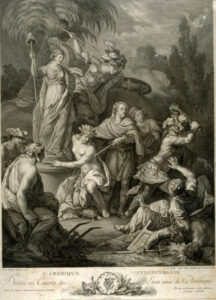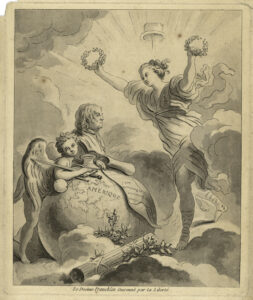It is common for nations to search for heroes to emulate a lofty standard for their citizens. Benjamin Franklin may be unique in that he ascended to the level of apotheosis, not initially from the acclaim of his own countrymen, but from citizens of the country abroad where he functioned as a diplomat.[1] One of the most important intellectual figures of the Revolutionary War, Franklin was articulate, ingenious, extraordinarily imaginative, an intellectual yet humble man who never indulged in conspicuous finery. To many, especially the French public where he served, he was an eighteenth century everyman.[2]
Franklin’s image was ubiquitous in France, appearing in paintings, sculptures, and engravings. It was found by the fireplaces of the poor, in the boudoirs of the beautiful and in the homes of both ordinary and aristocratic citizens of America’s war-time ally. During the “Festival of Liberty” his bust appeared next to those of Rousseau and Voltaire. Writing to his daughter Sarah Franklin Bache in 1779, Franklin explained about a medallion portrait she had referred to in a previous letter to him. Franklin noted that it had been made of different sizes, some for the lids of snuff boxes and others small enough to be set in rings, making his face as well-known as that of the moon. He said that the term “doll” a children’s toy is derived from the word idle. Therefore, the number of dolls now made of his likeness, in a sense, meant that he was “i-doll-ized” in France.[3]
Fortuitous circumstances made Franklin’s reception in France unexpectedly genial and wholehearted. The French people, being well versed with the doctrines of Rousseau, Voltaire and Montesquieu, saw in the struggling colonies an attempt to put these doctrines into practice. Therefore, they saw Franklin as the living embodiment of these ideas. Franklin’s unpretentious manners and approachable temperament complemented these ideals, making him a popular man in France. As he passed through the Parisian streets, he was followed by admiring eyes and occasionally cheered by enthusiastic voices. He was perhaps the Frenchman’s personification of the ideal citizen, a republican, philosopher, and an unassuming friend. Franklin captivated the people of France, whom he perfectly understood. He reasoned that a popular man could become more powerful than power itself. When Franklin died, most of France went into mourning for him.[4]
The former printer, publisher, Pennsylvania legislator, pluripotential diplomat, postmaster general, philosopher, author, inventor, scientist, and extraordinary polymath was laid to rest in the burying ground of Philadelphia’s Christ Church.[5] In his will he asked to be buried be side his wife under an unadorned marble slab with only a small molding around its upper edge inscribed Benjamin and Deborah Franklin, 178(-).[6] Unostentatious in life, his desire to preserve the same character after death was obeyed.
French Republicans allegorized the ordinary-appearing foreigner who ripped lightning from the sky and the scepter from tyrants. Paris vendors marketed Franklin’s likeness, some claiming it was made from Bastille stones. In portraits, his face shone alongside those of Voltaire and Rousseau. Two months after Franklin’s funeral in Philadelphia, it was announced to a silent French National Assembly that “Franklin est mort.” It was proposed that the members of the assembly should wear black for three days. He was eulogized at the Palais Royal and later at the Académie des Sciences. A passage from Franklin’s Poor Richard’s Almanac, “Having been poor is no shame, but being ashamed of it is,” were set in type, impressed upon paper, and delivered as broadsides to be distributed across Paris.[7]

Franklin, in an allegorical form, appeared in several influential French caricatures, popular cartoon depictions in that day. “L’Amérique Indépendante,” designed by A. Borel in 1778 and engraved inline by J. C. Levasseur, is the earliest effort at apotheosizing Franklin in a pictorial manner. Franklin, the central figure, appears in the classical costume of a Roman senator, bare legged, sandals, toga and tunic with a wreath adorning his head. His right hand rests upon the shoulder of America, represented by a female figure wearing a feathered crown, kneeling at the base of a Statue of Liberty holding her liberty cap aloft on a staff. Almost lost in the scene is a tortoise creeping away, representing the vanquished British. To the right is Mercury with the caduceus and Ceres with his foot on a ploughshare intently watching the tortoise making its way toward a vanquished Britannia, who has fallen beneath the club of Hercules and the prostrate body of Neptune (symbolic of its navy) whose trident is broken. Hovering over Franklin and the imagined scene is Victory.

The cartoon “Le Docteur Franklin couronné par la Liberté” was published in the Pennsylvania Gazette, on March 31, 1779. The principal figure is the Genius of Liberty descending on earth, both arms fully extended with a Laurel wreath in each hand. Surrounded with light, clouds representing ignorance and slavery are driven away by her presence. Before her is a bust of Franklin which she is about to crown with laurels; the apparent reason for her doing so is conveyed by a globe on his right hand, labelled Amerique, with fasces topped by olive branches bearing fruit. Behind and leaning on the globe, is bust of the doctor, with the sword of justice and other emblems in his right hand; In his left is a scroll falling upon the globe, on which is inscribed “Constitution of the Government of Pennsylvania.” “Doctor Franklin Crowned by Liberty” appears under the drawing.
According to the Gazette of Amiens, Mr. Fragonard, the King’s painter at Paris, rendered an elegant picture dedicated to the genius of Franklin. Franklin is represented opposing with one hand the aegis of Minerva to the Thunderbolt, which he knew how to fix by his conductors, and with the other commanding the God of War to fight against avarice and tyranny; while America, nobly declining upon him, and holding in her hand the fasces, an emblem of the union of the American states, looks down with tranquility on his defeated enemies. The artist expressed the idea of the Latin verse attributed to Turgot: “Eripuit fulmen coelo sceptrumque tyrannis” (He snatched the lightning from the skies and the scepter from the tyrants). [8]
Mirabeau arrive aux Champs Élisées by M.J. Moreau depicts a winged cherub floating above a mirror ball bearing a banner with the inscription le France libre.[9] Franklin, the second most central figure and only American in the scene, is depicted placing a crown of evergreens on his head. Montesquieu, Voltaire, Mably and Fénelon are shown coming forward to receive him. In the background Demosthenes and Cicero are conversing about the orator while raptly looking upon him.
In American publications, George Washington and later Abraham Lincoln were depicted as similar apotheosis figures in domestic drawings and paintings a little later. However, Franklin’s caricatured likenesses are distinctive because of the reverence he achieved while serving on a foreign shore for his emerging nation during its Revolutionary War.
[1] Apotheosis refers to the ascension of someone into a godhood state, an exaltation or the highest elevation one can reach. In ancient empires, some emperors were believed to become deities after their deaths. Congress’s message to the King of France announcing Franklin’s appointment read:
To our great, faithful, and beloved friend and ally, Louis XVI, King of France and Navarre. We have nominated Benjamin Franklin, Esqur., to reside at your Court in quality of our Minister Plenipotentiary that he may give you more particular assurances of the grateful sentiments which You have excited in us and in the United States. We beseech you to give entire Credit to everything which he shall deliver on our Part, especially when he shall assure you of the Permanency of our Friendship, and we pray God that He will keep your Majesty, our great, faithful, and beloved Friend and Ally, in his most holy Protection.
Given Philadelphia on the 21st day of October 1778 by the Congress of the United States of North America, you’re good friends and allies.
Henry Laurens, Presd.
In announcing his appointment to his cousin, Jonathan Williams, Franklin wrote from Passy, February 13, 1779:
I have the pleasure of acquainting you that the Congress has been pleased to honor me with a sole appointment to be their Minister Plenipotentiary at this Court, and I have just received my credentials. This mark of public confidence is more agreeable to me as it is not obtained by any solicitation or intrigue on my part, nor have I ever written a syllable to any person in or out of Congress magnifying my own services or diminishing those of others.
[2] Although a Quaker, a religious sect known for its pacifism, Franklin served as a colonel in the Pennsylvania Militia during the French and Indian War.
[3] Charles Henry Hart, “Franklin in Allegory,” The Century Magazine, vol. XLI no.2 (December 1890), 199.
[4] Benjamin Franklin died on Saturday, April 17, 1790.
[5] Franklin lightheartedly composed his own epitaph in his twenties: “The Body of B. Franklin, Printer: (Like the Cover of an old Book its Content torn out and stripped of its Lettering and Gilding) Lies here, Food for Worms. But Work shall not be lost: For it will, (as he believed) appear once more, in a new and elegant Edition, revised and corrected, by the Author.”
[6] The marble gravestone was to be six feet long and four feet wide. It has been speculated that Franklin, as a former imprinter, knew that these dimensions would make it look like he and his wife would forever rest under a sheet of newsprint.
[7] Poor Richard’s Almanac 1749.
[8] Portraits of Franklin as a god-like figure contained an inscription attributed to Turgot proclaiming, “Eripuit fulmen coelo sceptrumque tyrannis” (He snatched the lightning from the skies and the scepter from the tyrants).
[9] Politician and orator, Honoré-Gabriel Riqueti, Comte de Mirabeau, was a renowned figure in the French National Assembly that governed the realm during the early phases of the French Revolution (1789-99).





Recent Articles
New Jersey’s Revolutionary Rivalry
The Evolution of the American Declaration of Independence
The Deadliest Seconds of the War
Recent Comments
"The Evolution of the..."
This article is a gem. Sparkling. Excellent research. Wide and deep. Thank...
"The Evolution of the..."
A very interesting article, thank you! A more general question, if you...
"The Evolution of the..."
Thoroughly researched and a succinct presentation, especially given the article's breadth.